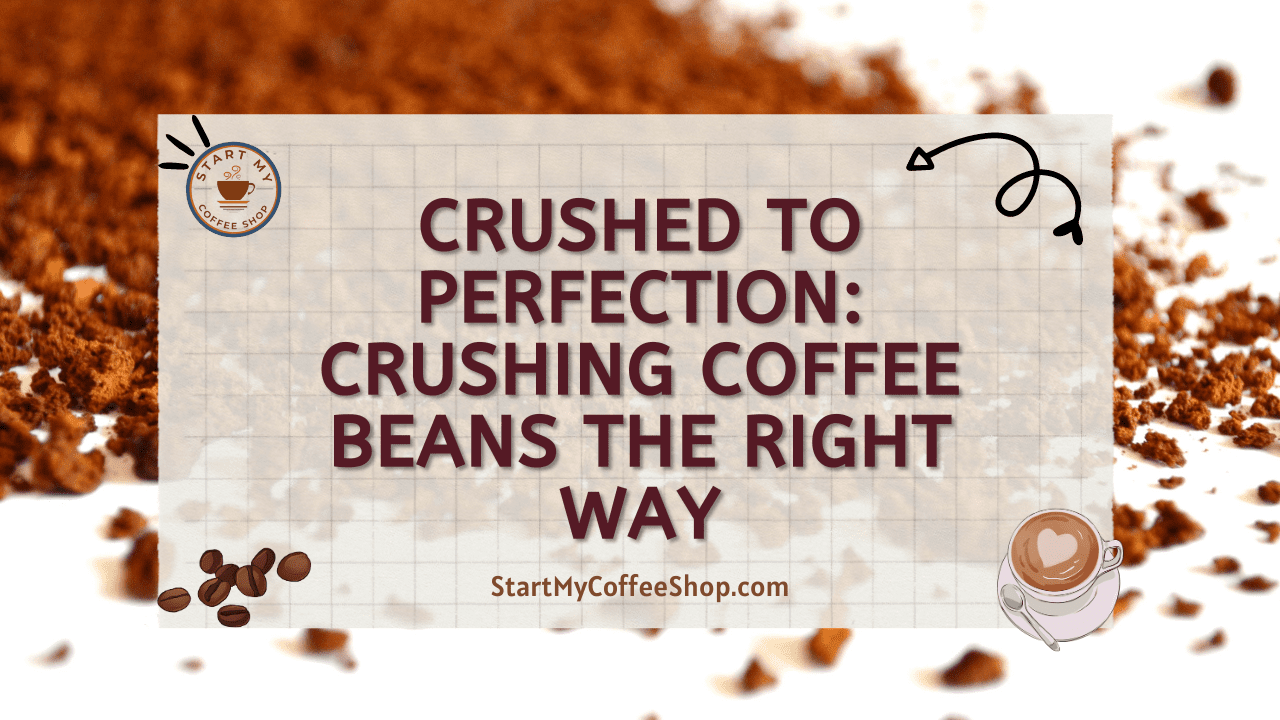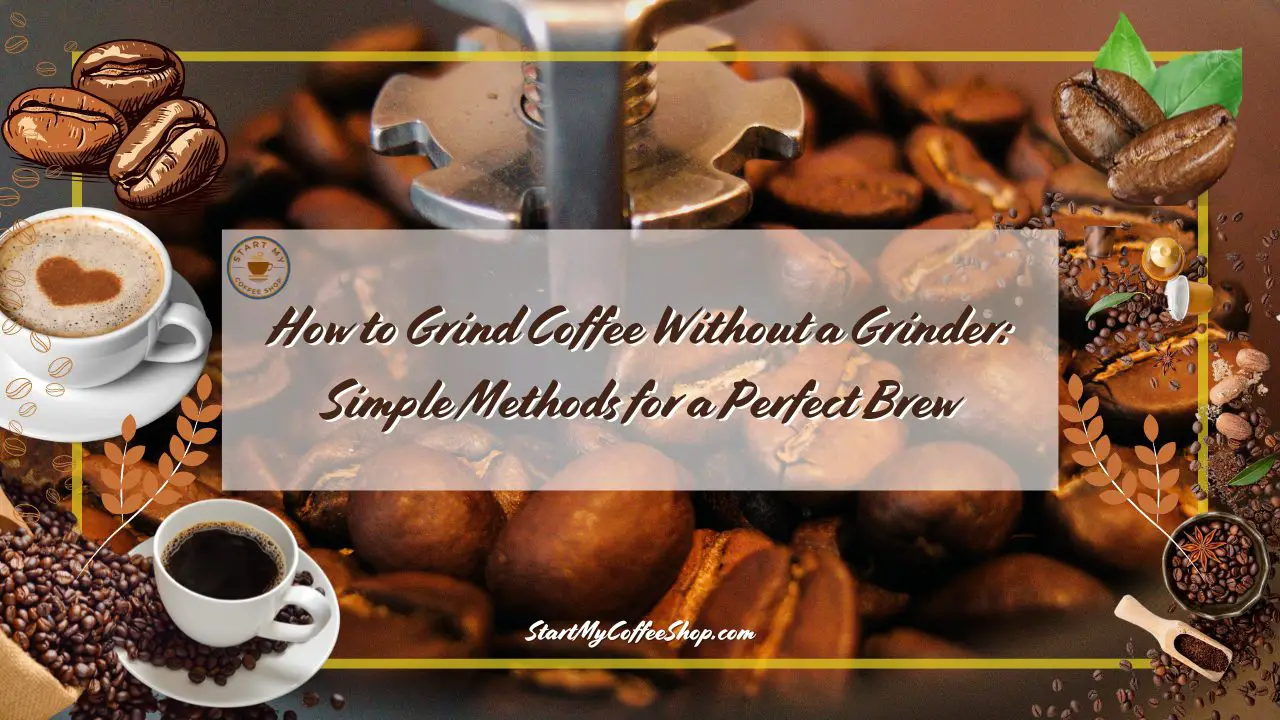Coffee lovers understand that the quest for the perfect cup of coffee begins well before the first sip. Everything begins with the critical process of crushing coffee beans, which has a considerable impact on the taste, aroma, and overall quality of the brew. Finding the proper method may be both exhilarating and overwhelming, with so many strategies and tools accessible.
To crush coffee beans effectively, you should use a burr grinder to achieve the desired coarseness. Be cautious of over-grinding, as it can lead to bitterness. Consistent grinding ensures optimal flavor extraction from the beans.
This article delves into the art of crushing coffee beans. Prepare to start on a joyful examination of the art of making a truly great cup of coffee, whether you’re a seasoned barista or a coffee newbie.
The Burr Grinder: A Tool for Precision
The fundamental step of grinding the coffee beans is where the process of making the ideal cup of coffee begins. The finished brew’s flavor and quality can be substantially affected by this ostensibly straightforward operation. Despite the wide variety of coffee grinders on the market, the burr grinder has been the favorite option for coffee lovers.
Among the several coffee grinder varieties, the burr grinder has developed a reputation for offering dependable and consistent performance. Burr grinders work with accuracy and refinement in contrast to blade grinders, which use sharp blades to cut the beans unevenly. To effectively smash the coffee beans, they use two burr-like abrasive surfaces. These burrs normally come in two shapes—conical and flat—and are composed of metal or ceramic. The beans are fed into the space between the burrs and uniformly ground as they move through the precisely measured space between the burrs.
The burr grinder’s main benefit is its capacity to produce constant particle size, which is necessary for getting the proper coarseness of the coffee grounds. Coffee brewing requires consistency since irregular particles can cause over- or under-extraction, which results in a bitter or weak cup of coffee. Whether you enjoy making espresso, pour-over, French press, or cold brew, you have the freedom to modify the grind size with a burr grinder.
For example, espresso lovers need a very fine grind to get the most flavor out of the coffee beans. They can continuously obtain this fine grind thanks to the burr grinder’s exact settings, which guarantees an excellent extraction during the espresso brewing process. The burr grinder can simply produce the ideal coarseness for this style of brewing as well. On the other hand, individuals who prefer French press coffee benefit from a coarser grind to prevent over-extraction.
The burr grinder gives you complete control over the grinding procedure, guaranteeing that the coffee beans are only ground as needed. Pre-ground coffee can quickly lose its flavor owing to exposure to air since it lacks the freshness and aroma of freshly ground beans. The inherent oils and flavors of the coffee are preserved by grinding the beans right before brewing, producing a cup with more aroma and flavor.
Burr grinders’ sturdiness and lifetime are also important to note. Burr grinders are made to sustain extended usage without losing performance thanks to their solid construction and powerful burr plates. In comparison to blade grinders, which are sometimes less sturdy and may quickly wear out with continuous usage, this durability is a key advantage.
The greater grind quality and all-around coffee experience that burr grinders offer make them a worthy investment, even though they are typically more expensive than blade grinders. The long-term savings realized by grinding whole coffee beans rather than purchasing pre-ground coffee also serve to justify the cost.
Read more about: Cost to Open a Coffee Bar: A Cappuccino Economics
The Perils of Over-Grinding
The technique of grinding coffee beans is a prime example of how the pursuit of the ideal cup of coffee necessitates a precise balance between accuracy and competence. Even though a burr grinder provides unmatched accuracy in reaching the correct coarseness, it also necessitates a keen eye and attention to detail to avoid a common error that can result in dissatisfaction with your brew—over-grinding.
When coffee beans are ground excessively finely, this is known as over-grinding, and it causes an excessive extraction of bitter chemicals during the brewing process. The delicate smells and lovely aromas that make each cup of coffee a special experience might be overpowered by the bitter taste. Avoiding this trap is essential, especially when using brewing techniques where the coffee grinds are in touch with the water for a long time, such as cold brew or French press.
A coarser grind is essential for French press coffee, which is renowned for its rich and powerful flavor profile. This grind achieves the ideal balance between flavor extraction and reducing bitterness. Coffee beans that are ground too finely will have an excessive amount of bitter chemicals extracted from them during the extraction process. As a result, the coffee could turn excessively bitter and unpleasant. The burr grinder’s movable settings enable you to retain the coarser grind required for this method, resulting in a smooth and gratifying French press brew.
Similar to cold brew coffee, which has a smooth and energizing flavor, cold brew coffee requires a coarser grind to prevent bitterness. Larger coffee particles are needed for the slow, cold water extraction method to avoid over-extraction. It can become very bitter and unappealing if the beans are ground too finely, especially on a hot summer day when a smooth and cooling cold brew is most desired.
Coffee lovers must be aware of the subtleties of their preferred brewing techniques and alter their burr grinder settings properly to avoid the bitter traps of over-grinding. Burr grinders’ versatility enables you to tailor the coarseness to your preferences, guaranteeing a delicious cup of coffee every time.
It takes effort and experimentation to master the art of grinding uniformity. As you learn more about coffee, you’ll find that various coffee bean types, roast levels, and brewing techniques may require little changes to the grinder settings to get the finest results. With each adjustment, you get a little bit closer to perfecting the art of grinding and brewing, and the process itself becomes joyful.
It is crucial to approach the burr grinder as a useful instrument rather than just a standard kitchen item. You will be rewarded with a gratifying coffee experience that showcases the distinctive qualities of the beans and the brewing technique you’ve chosen if you pay attention to the grind size and make adjustments as necessary.
Consistency is Key
Consistent grinding is a vital idea in the art of coffee brewing that cannot be disregarded. The method of grinding coffee beans to the ideal size has a significant impact on the finished cup’s flavor and quality. Each coffee particle will be the same size thanks to consistent grinding, which will result in an even extraction during the brewing process. The result is a cup of coffee that is rich, well-balanced, and genuinely reflects the flavor of the beans.
The consistency of the grinding is crucial for several brewing processes, including drip coffee makers, pour-over methods, and espresso machines. In these procedures, while the water flows, the coffee grounds are passed through to extract flavors and fragrances. If the particle size varies, some grounds may undergo over-extraction, releasing excessive bitterness and unpleasant chemicals, while others will undergo under-extraction, producing sour and weak flavors. A potentially fantastic cup of coffee can become unsatisfactory due to inconsistent brewing methods, which fall short in terms of flavor and quality.
Consider using a drip coffee maker to prepare coffee, which relies on a constant stream of hot water running through the coffee grounds. Inconsistent grind size causes some particles to delay the flow, which leads to over-extraction and bitterness. Other particles might permit water to pass through too rapidly, resulting in inadequate flavor extraction and under-extraction. The result is a brew that lacks harmony and does not fully express the coffee’s potential.
When employing pour-over techniques, where the water is slowly poured over the coffee grounds, consistency is even more important. The homogeneity of the grind is necessary for the even extraction of tastes, enabling a managed brewing process. The grind size is crucial to attaining the ideal taste in pour-over brewing because the barista or coffee aficionado has more control over the factors.
The grinding must be accurate and constant for espresso machines as well. A particular grind size is necessary for the high-pressure water extraction process used to make espresso to create the ideal harmony of acidity, sweetness, and bitterness. Shots that are either too weak and watery or too bitter and overwhelming might result from inconsistent grinding.
Coffee lovers are urged to spend money on a high-quality burr grinder to get the desired consistency in grinding. Burr grinders provide exact control over grind size in contrast to blade grinders, which create inconsistent grounds. The burr grinder uses two burrs, or abrasive surfaces, to grind materials to the required degree of coarseness. You may adjust the grind size to fit your favorite brewing method with this versatility, whether you like a fine grind for espresso or a coarser one for pour-over.
It’s important to pay attention to the grinder’s settings and modify them as necessary for various brewing techniques. You may perfect your brewing technique and improve your coffee experience by experimenting with various grind sizes and noticing the differences in flavor in the finished cup.
The Influence of Grind Size on Brewing Methods
When choosing the best brewing technique for your beans, the coarseness of the coffee grind is a key factor. You can maximize the use of your coffee beans by knowing how grind size and brewing techniques relate to one another.
- Coarse Grind: Perfect for several drip coffee brewers, cold brew, and French presses. Larger particles prevent over-extraction during prolonged steeping intervals, producing a cup of coffee that is robust and flavorful.
- Medium Grind: Suitable for pour-over techniques and drip coffee makers with flat-bottom filters. This grind provides a well-rounded cup with nuanced flavors by striking a balance between flavor and brewing time.
- Fine Grind: It’s mostly used with some pour-over techniques and espresso makers. The quicker extraction due to the smaller particles results in a concentrated burst of potent flavor and aroma.
Factors Affecting Coffee Bean Crushing
We have looked at the value of the burr grinder, the dangers of over-grinding, and the significance of consistency in reaching the right grind size in our quest for the perfect cup of coffee. The freshness of the beans is one of the important variables that come into play when crushing coffee beans.
A crucial component of coffee bean quality is freshness. Coffee beans “degas” after roasting, which is the release of carbon dioxide. This gas release is a typical process that occurs after roasting the coffee bean. The beans are at their freshest and most flavorful during this time, which usually lasts for a day or two after roasting.
Before grinding newly roasted beans, it is best to let them degas first. As a result of the increased carbon dioxide, grinding the beans right away after roasting may cause irregular extraction during brewing. The beans can stabilize by waiting for a day or two, which results in a cup of coffee that is more flavorful and balanced.
The type of coffee beans you select is a crucial element that affects the coffee grinding process. Different coffee bean varietals have unique flavor, fragrance, body, and acidity characteristics. Some beans could have fruity and floral overtones, while others might have nutty or chocolatey ones. These innate characteristics may affect the size of the grind, which may therefore affect the extraction of taste during brewing.
To prevent over-extraction and preserve their delicate flavors, some beans, for instance, may benefit from rougher ground. However, certain beans might need a finer ground to completely extract their complex flavors and fragrances. A coffee fan must experiment with different bean varietals and discover how their special qualities interact with varied grind sizes and brewing techniques.
The degree of roasting the coffee beans can have a big impact on how the beans are ground and how much flavor is extracted. There are many roast levels, from light to medium to dark to very dark. Darker roasts produce strong, smoky, and caramelized overtones, whilst lighter roasts typically have more acidity and preserve the natural tastes of the beans.
The ideal grind size for brewing is also influenced by the roast intensity. Darker roasts may perform better with a rougher grind to prevent excessive bitterness, whilst lighter roasts often require a finer grind to optimize flavor extraction. You can adjust your coffee brewing to suit your taste preferences by knowing how roast degree, grind size, and brewing method interact.
Accepting experimentation with various beans and roast levels as a dedicated coffee enthusiast can be a fun and gratifying adventure. You can discover the numerous flavor profiles that are concealed within distinct coffee beans by experimenting with different pairings, which opens up a world of coffee options.
Read more about: Cost to Open a Coffee Cart: Calculating the Cost of Entry
Frequently Asked Questions
What are the benefits of crushing coffee beans with a burr grinder?
A burr grinder provides precise and consistent grinding, letting you fine-tune the coarseness for different brewing procedures. This results in optimal flavor extraction and a well-balanced cup of coffee, which improves the overall coffee brewing experience.
How does over-grinding influence coffee flavor?
Over-grinding coffee beans results in a finer grind, which releases more bitter chemicals during brewing. As a result, the coffee has a bitter and disagreeable taste. It is critical to avoid over-grinding, especially when using lengthier steeping methods like a French press or cold brew.
Why is consistent grinding so important in coffee brewing?
Consistent grinding guarantees that all coffee particles are the same size, resulting in equal extraction during the brewing process. This uniformity eliminates over- and under-extraction, resulting in a more balanced flavor profile and a more pleasurable cup of coffee.
To learn more on how to start your own coffee shop, check out my startup documents here.
Disclaimer: The information provided by StartMyCoffeeShop.com (“The Site”) is for general informational purposes only. All information on the Site is provided in good faith. However, we make no representation or warranty of any kind, express or implied, regarding the accuracy, adequacy, validity, reliability, availability, or completeness of any information on the Site. Under no circumstance shall we have any liability to you for any loss or damage of any kind incurred as a result of the use of the Site or Reliance on any information provided on the Site. Your use of the Site and reliance on any information on the Site is solely at your own risk. This blog post is for educational purposes only and does not constitute legal advice. Please consult a legal expert to address your specific needs. Terms and Conditions. (https://startmycoffeeshop.com/terms-and-conditions/)

Hi! I’m Shawn Chun
My adventure in coffee began when I first launched my first coffee shop back in the early 2000s. I had to figure out so many things on my own and to make it worse within 2 years of opening two large corporate coffee chains moved in just blocks away from me!
As I saw smaller and even some larger coffee shops in the neighborhood slowly lose customers to these giant coffee chains and slowly close up shop, I knew that I had to start getting creative…or go out of business.
I (like you may be) knew the coffee industry well. I could make the best latte art around and the foam on my caps was the fluffiest you have ever seen. I even had the best state-of-the-art 2 group digital Nuova Simonelli machine money could buy. But I knew that these things alone would not be enough to lure customers away from the name brand established coffee shops.
Eventually, through lots of trial and error as well as perseverance and creativity I did find a way to not only survive but also thrive in the coffee/espresso industry even while those corporate coffee chains stayed put. During those years I learned to adapt and always faced new challenges. It was not always easy, however, in the end, I was the sole survivor independent coffee shop within a 10-mile radius of my location. Just two corporate coffee chains and I were left after that year. All told the corporate coffee chains took down over 15 small independent coffee shops and kiosks and I was the last one standing and thriving.
Along the years I meet others with the same passion for coffee and I quickly learned that it is not only “how good a barista is” that makes a coffee shop successful, but the business side of coffee as well.
Hence why I started this website you are on now. To provide the tools and resources for up and coming coffee shop owners to gain that vital insight and knowledge on how to start a coffee shop successfully.
Stick around, browse through my helpful blog and resources and enjoy your stay! With lots of LATTE LOVE!
Shawn






